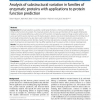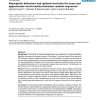283 search results - page 48 / 57 » Clustering Similarity Comparison Using Density Profiles |
BMCBI
2010
13 years 9 months ago
2010
Background: Structural variations caused by a wide range of physico-chemical and biological sources directly influence the function of a protein. For enzymatic proteins, the struc...
BMCBI
2006
13 years 9 months ago
2006
Background: The number of k-words shared between two sequences is a simple and effcient alignment-free sequence comparison method. This statistic, D2, has been used for the cluste...
BMCBI
2007
13 years 9 months ago
2007
Background: Regulation of gene expression is relevant to many areas of biology and medicine, in the study of treatments, diseases, and developmental stages. Microarrays can be use...
CIBCB
2006
IEEE
14 years 3 months ago
2006
IEEE
Abstract–Protein families can be used to reconstruct evolutionary histories of organisms. The accuracy of protein assignment to such families is critical for the success of such ...
BMCBI
2010
13 years 9 months ago
2010
Background: Sequence comparisons make use of a one-letter representation for amino acids, the necessary quantitative information being supplied by the substitution matrices. This ...


